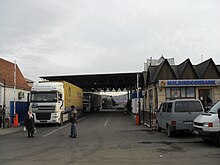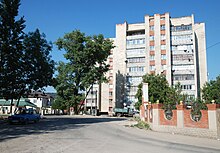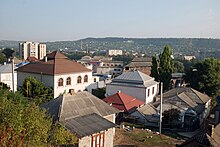Otaci
|
Otaci ( rum. )
|
||
| State : |
|
|
| Administrative unit : | Ocnița district | |
| Coordinates : | 48 ° 26 ' N , 27 ° 48' E | |
|
|
||
Otaci , formerly Russian Атаки Ataki , is a small town and administrative center of the Ocnița Rajon in the extreme northeast of the Republic of Moldova on the Moldovan-Ukrainian border . From the city on the right (western) bank of the Dniester (Romanian Nistru) there is an official border crossing over a road bridge to the Ukraine .
In the 1930s, almost 80 percent of the population was Jewish . Today the largest Roma minority in the country outside of the capital lives here .
location
Otaci is located around 215 kilometers by road north of the state capital Chișinău in Ocnița Rajon, the northernmost district of the republic. In addition to the district capital Ocnița, 25 kilometers to the west, Otaci is the only small town in the district with 8,469 inhabitants in the 2004 census. The place Frunză on the route between Otaci and Ocnița, also officially run as an urban settlement, had only 1,476 inhabitants in 2004. The distance to the next larger town of Soroca downstream in a south-easterly direction is 56 kilometers and approximately the same in direction south-west to Edineț . The R8 road from Otaci to Edineț continues to Bălți , the largest city in Northern Moldau. On the opposite bank of the Nistru lies the Ukrainian border town of Mohyliw-Podilskyj . A measuring point of the Struve arch is located in the village of Rudi around 15 kilometers south of Otaci.
The railway bridge between Otaci and Mohyliw-Podilskyj is the only direct train connection over the Nistru between Moldova and Ukraine, as the train connections further south cross the internationally unrecognized state structure of Transnistria . About eight kilometers south of Otaci, a footbridge connects the Moldovan village of Ungeni with Bronnitsa on the Ukrainian side. It serves the small border traffic of the local population. On the side road to Ungeni, which branches off the main road towards Soroca to the east in Otaci and directly follows the river, the elongated village of Călărăşeuca begins after about two kilometers, at the end of which a good six kilometers from Otaci is the Călărăşeuca monastery founded in the 18th century lies.
In contrast to the greater part of northern Moldau, which consists of extensive, flat hills overgrown with steppe grass, on which cereals and sunflowers are grown, the northernmost part of the country, especially along the Nistru, is characterized by small hills, predominantly overgrown with thick deciduous forest. The river bed of the Nistru is cut in the soft sedimentary rock, in some places on the slopes, geologically older and firmer limestones emerge.
history
From the 15th century, the area was on the eastern border of the Principality of Moldova in Bessarabia , which had been under Ottoman rule since the beginning of the 16th century . During this time, Otaci was a trading place with a regular market. With the victory of Russia in the Russo-Turkish War in 1812, Bessarabia came under Russian control.
In the second half of the 18th century a Jewish community grew in Otaci, which in 1817 consisted of 353 families and almost half of the 773 families. The number of Jews increased steadily through immigration to Bessarabia and had grown to 559 families by 1847. They owned a synagogue and three houses of prayer. With the construction of the railway line in 1893, many Jewish traders lost their livelihoods. Some of them emigrated to the United States, while at the same time rural Jews were moving to the cities. In 1897 of the 6,980 inhabitants, 4,690 were Jews (67.2 percent). At the turn of the century, 832 Jewish families are given among the total of around 1000 families.
Since 1791, Jews were only allowed to settle in the Russian Empire in certain areas known as the Pale of Settlement , to which Bessarabia belonged. After Russia came to power in 1812, numerous Jewish craftsmen and traders from Poland, Ukraine and Galicia came to the former Ottoman Bessarabia. Many Jews were settled in their own agricultural colonies. After unrest among the rural population and pogroms against the Jews from 1881 to 1884, many fled to the cities, where in some places they made up a third or more of the population.
In 1930, under Romanian rule of around 3500 inhabitants, there were 2,781 Jews (79.4 percent). In the 1930s, a Jewish kindergarten and a Jewish school through the Tarbut organization ( Tarbut, Hebrew “culture”, secular Zionist educational initiative) were founded. Right-wing extremist groups generally fomented aggression against Jews who defended themselves with their own vigilante groups. On June 28, 1940, the Romanian government left Bessarabia to the advancing Red Army . Otaci was in the area of Bessarabia that was assigned to the Moldovan Soviet Socialist Republic (MSSR). After Romania entered the Second World War on the Axis side on June 22, 1941, the Soviets had to withdraw from Bessarabia in July. At the beginning of the fighting, the Soviet authorities forbade all Bessarabian citizens to leave the country for Ukraine. When the ban was lifted after about ten days, the German Air Force had already destroyed most of the road and rail bridges over the Nistru, making escape extremely difficult. At the end of June the many Jews gathered in Otaci were allowed to flee over a temporary bridge built by the Soviets over the Nistru. There were many deaths because the bridge was bombed. Days later, German units caught up with the fleeing Jews, drove them back or shot them on the spot.
Bessarabia was now occupied by German and Romanian troops. In the autumn of 1941 - under the blanket pretext of being pro-Soviet - almost all Bessarabian Jews were expelled and cruelly deported to Transnistria , where a large number of them perished. Otaci was one of the terminus to which thousands of Jews were brought by train and from where they were mostly driven further east on foot. For example, several thousand Jews were transported from Czernowitz in closed freight wagons to the Otaci and Mărculești stations in mid-October 1941 . Around this time Jews from southern Bukovina were also being transported to Otaci in cattle cars . Shortly before the terminus, their valuables were taken from them during a stop at the Vălcineț stop. The railway wagons lined up in Otaci were at times up to two kilometers in length. At the end of 1941 there were practically no more Jews living in Bessarabia. Nothing is known about the fate of the Jews previously living in Otaci, but it is likely that they, like the other Jews in Bessarabia, were completely expelled and most of them were killed.
Cityscape
In the 2004 census, the number of Jews in the city of Otaci was 9 and in the whole of Ocnița Raion it was 14. What makes Otaci stand out today are the 3380 Roma , who were counted in 2004 and make up 40 percent of the urban population. In 1989, when the last census of the socialist era took place in the area of Moldova, which became independent in 1991, Roma were living in Otaci in 1993. This means that Otaci, with the exception of Chișinău, has more Roma than any other city in Moldova. Soroca, which is known as the “Gypsy capital of Moldova” because of its villas built by wealthy Roma, follows in second place. The majority of the inhabitants in 2004 were Ukrainians (3784), further a distinction was made: Moldovans (724), Russians (521), Gagauz (14), Romanians (9), Bulgarians (7), Poles (4) and others (15). Otaci received city status ( oraş ) in 1994.
The center of Otaci is the area in front of the border clearance at the bridge. Here you will find a market, grocery stores, banks and the bus stop for minibuses (in Russian marshrutki ). Some apartment blocks from the socialist era tower above the usual one to two-story single-family houses with hipped roofs. The former synagogue was used as a cultural center during the Soviet era. According to a 2010 report, the building, which is now owned by Jews, is empty and in poor condition. To the west, the residential houses surrounded by gardens stretch up the hill. To the southeast, along the river bank, the buildings merge almost seamlessly into the village of Călărășeuca. The railway bridge crosses the river one kilometer upstream from the road bridge. Industrial companies follow further north, filling the plain on the river. The train station in the local district of Vălcineț is seven kilometers from the center.
Jewish Cemetery
Above Vălcineț, on the ridge of the hill, there is an old Jewish cemetery surrounded by bush forest . A partially collapsed wall surrounds the 19th century cemetery. Some gravestones have fallen over or overgrown with grass, their total number is said to have been 3500. According to other information, around 1000 tombstones were still preserved in 1992 and over 500 in 2010. There is a guard who takes care of the facility regularly.
Others
The city football club is FC Nistru Otaci .
literature
- Klaus Bochmann, Vasile Dumbrava, Dietmar Müller, Victoria Reinhardt (eds.): The Republic of Moldau. Republica Moldova. A manual. Leipziger Universitätsverlag, Leipzig 2012, ISBN 978-3-86583-557-4
Web links
- Herman Rosenthal: Ataki . Jewish Encyclopedia, 1906
- Ataki, Moldova. Encyclopedia Judaica, 2008
Individual evidence
- ↑ Demographic, national, language and cultural characteristics. (Excel table in Section 2) National Bureau of Statistics of the Republic of Moldoca
- ↑ Dmitri Liutkanov: Field Office Otaci. ( Memento of the original from August 13, 2015 in the Internet Archive ) Info: The archive link was inserted automatically and has not yet been checked. Please check the original and archive link according to the instructions and then remove this notice. European Union Border Assistance Mission (EUBAM)
- ^ Wilfried Heller, Mihaela Narcisa Arambașa: Geography. In: Klaus Bochmann u. a. (Ed.): The Republic of Moldova , p. 161
- ↑ Ataki, Moldova. Encyclopedia Judaica. 2008
- ^ Mariana Hausleitner: Germans and Jews. The legacy of the disappearing minorities . In: Klaus Bochmann u. a. (Ed.): The Republic of Moldova , p. 218
- ^ Jean Ancel : The History of the Holocaust in Romania . (The Comprehensive History of the Holocaust) University of Nebraska Press, Lincoln, and Yad Vashem, Jerusalem 2011, pp. 236, 279, 291, 294
- ↑ Vladimir Solonari: The Moldavian Soviet Socialist Republic during the Second World War (1941-1945). In: Klaus Bochmann u. a. (Ed.): The Republic of Moldova, p. 93
- ↑ Demographic, national, language and cultural characteristics . (Excel table in Section 7) National Bureau of Statistics of the Republic of Moldoca
- ^ Jewish Heritage Sites and Monuments in Moldova. ( Memento of the original from December 27, 2016 in the Internet Archive ) Info: The archive link was inserted automatically and has not yet been checked. Please check the original and archive link according to the instructions and then remove this notice. United States Commission for the Preservation of America's Heritage Abroad, Washington 2010, pp. 59f
- ↑ Otaci. Jewish Cemetery. ( Memento of the original from July 22, 2011 in the Internet Archive ) Info: The archive link was inserted automatically and has not yet been checked. Please check the original and archive link according to the instructions and then remove this notice.
- ^ Miriam Weiner: Jewish Roots in Ukraine and Moldova: Pages from the Past and Archival Inventories. (The Jewish Genealogy Series). The Miriam Weiner Roots to Roots Foundation, YIVO Institute for Jewish Research, New York 1999, p. 352 ( online )




